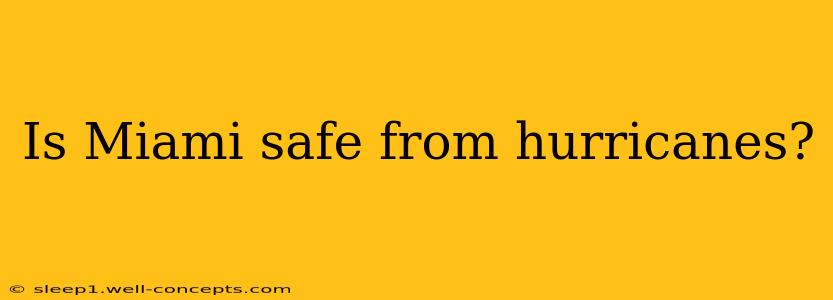Miami, a city synonymous with sun-kissed beaches and vibrant nightlife, also sits squarely in the path of Atlantic hurricanes. The question, "Is Miami safe from hurricanes?" isn't a simple yes or no. The reality is far more nuanced, involving a complex interplay of geographical location, infrastructure, preparedness, and the unpredictable nature of these powerful storms.
Miami's Vulnerability to Hurricanes
Miami's location on a low-lying peninsula makes it highly vulnerable to hurricane impacts. The city's proximity to the warm waters of the Atlantic Ocean fuels hurricane formation and intensification, increasing the likelihood of direct hits. Several factors exacerbate this vulnerability:
-
Low Elevation: Much of Miami-Dade County sits just a few feet above sea level, making it susceptible to storm surge flooding, even from relatively weak hurricanes. This flooding can cause widespread damage to property and infrastructure, disrupt essential services, and pose a significant threat to human life.
-
Coastal Exposure: Miami's extensive coastline provides a direct path for hurricane winds and storm surge to penetrate deep inland. The city's numerous bridges and causeways, while essential for transportation, can also act as funnels for storm surge, amplifying its destructive power.
-
Dense Population: Miami's large and densely populated urban area means a significant number of people are at risk during a hurricane. Evacuating such a large population efficiently and safely presents considerable logistical challenges.
Miami's Hurricane Preparedness and Mitigation Efforts
Despite its vulnerability, Miami isn't defenseless. Significant efforts have been made to improve hurricane preparedness and mitigation:
-
Improved Building Codes: Stringent building codes mandate hurricane-resistant construction, aiming to minimize damage from high winds and storm surge. Newer buildings are generally better equipped to withstand hurricane-force winds.
-
Early Warning Systems: The National Hurricane Center provides accurate and timely forecasts and warnings, allowing residents and authorities to prepare for approaching storms. Improved communication systems ensure timely dissemination of vital information.
-
Evacuation Plans: Comprehensive evacuation plans are in place to guide residents to safety in the event of a hurricane threat. Designated evacuation routes and shelters help manage the large-scale movement of people.
-
Seawalls and Coastal Defenses: Some areas of Miami have invested in seawalls and other coastal defenses to mitigate storm surge. However, the extent of these defenses is limited, and their effectiveness varies depending on the intensity of the storm.
-
Community Preparedness Programs: Various community-based initiatives educate residents on hurricane preparedness, fostering a culture of proactive risk management.
The Bottom Line: Is Miami Safe?
The answer remains complex. While Miami is not inherently safe from hurricanes, it is becoming increasingly resilient. The city's vulnerability is undeniable, but ongoing efforts in infrastructure improvements, early warning systems, and community preparedness programs are crucial in mitigating the risks associated with hurricanes. Ultimately, the safety of Miami during a hurricane depends heavily on the intensity of the storm, the effectiveness of preparedness measures, and the individual actions taken by residents.
Beyond the immediate threat: Long-Term Considerations
Looking ahead, Miami faces long-term challenges related to climate change and rising sea levels. These factors will likely increase the frequency and severity of future hurricane impacts, necessitating further investment in adaptation and mitigation strategies. Understanding these long-term risks is crucial for ensuring the future safety and well-being of Miami's residents.

